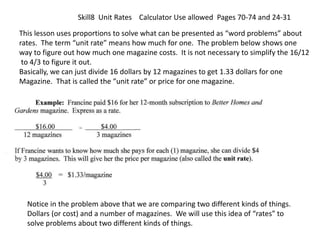
Skill8 unit ratesand ratios
- 1. Skill8 Unit Rates Calculator Use allowed Pages 70-74 and 24-31 This lesson uses proportions to solve what can be presented as “word problems” about rates. The term “unit rate” means how much for one. The problem below shows one way to figure out how much one magazine costs. It is not necessary to simplify the 16/12 to 4/3 to figure it out. Basically, we can just divide 16 dollars by 12 magazines to get 1.33 dollars for one Magazine. That is called the “unit rate” or price for one magazine. Notice in the problem above that we are comparing two different kinds of things. Dollars (or cost) and a number of magazines. We will use this idea of “rates” to solve problems about two different kinds of things.
- 2. Proportions page 25 We will use an important idea from mathematics to solve these problems. I like to call it “the product of the means – the product of the extremes.” It isn’t necessary for us to go into a lot of detail about this if you just understand what it means. Read more about this on page 25 A and B if you have it in your book. Note: This has NOTHING to do with multiplying fractions. I like to say “you just multiply the top number from one side by the bottom number from the other side and then set that multiplication equal to the multiplication of the other top number by the bottom number of the other side.” In the problems we will be solving, there will be two different quantities involved in the problem. Usually there will be two sentences that give two different sets of facts about these quantities. We will write a fraction for each sentence and set the fractioons equal to each other. The use the product of the means = the product of the extremes to solve. Solve: 2 times N = 7 times 8 2n = 56 then divide both sides by 2 n = 56 This should look familiar.
- 3. Now we will start solving problems like you might see on the test. From page 27. Page 29 and 30 have some problems worked out. Notice the two quantities in this problem---miles and minutes. Make a fraction ratio for the first sentence. ( put miles over minutes but you could have put minutes over miles. Then write a fraction for the second sentence. Use a letter for the part you don’t know which is “how long” or minutes for 4.8 miles. Of the four parts of the problem, you will be given three. Use a letter for the one part you don’t know. Look at the work. Do you see how I wrote the second line? Solve like any other equation. It would take 40 minutes. Note: There are other ways to solve these. It doesn’t matter what way you use. Just be sure it makes sense and you get it right.
- 4. I put dollars over hours for both sentences. Change the fractions to decimals. I put miles over hours. So, 262. 5 miles in 1 ¼ hours.
- 5. Some unit rate problems from page 70. Don’t worry if you don’t know the units like BTU, etc. Just use the numbers.
- 6. Try some problems on page 74. They have answers.
- 7. A very practical problem you might see is a “better buy” problem. Given two items at different prices, pick which is the cheapest.